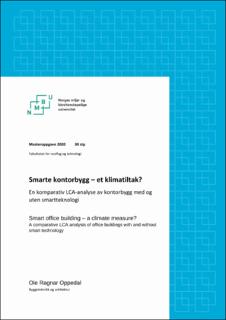| dc.contributor.advisor | Thiis, Thomas Kringlebotn | |
| dc.contributor.author | Oppedal, Ole Ragnar | |
| dc.date.accessioned | 2020-08-05T09:32:56Z | |
| dc.date.available | 2020-08-05T09:32:56Z | |
| dc.date.issued | 2020 | |
| dc.identifier.uri | https://hdl.handle.net/11250/2670900 | |
| dc.description.abstract | Smarte kontorbygg har i de seneste årene fått stor oppmerksomhet. Gevinster som redusert energiforbruk, økt produktivitet og bedre trivsel brukes i markedsføring av disse byggene. Byggebransjen er inne i en periode der miljø og klimavennlige bygg står på agendaen. Bygninger med nullklimagassutslipp knyttet til produksjon, drift og avhending har vært en målsetting. Også bygg som produserer mer ren og fornybar energi enn det forbruker over livsløpet er lansert. Mens det tidligere ble antatt at bruksfasen bidrar betydelig når det gjelder energibruk, har materialbrukens miljøpåvirkning nå kommet mer i fokus.
Uklarhet om hva et smartbygg er, og manglende standarder for slike bygg kan forsinke utviklingen av smartbygg fordi det da kan være vanskelig for byggeier å se gevinsten i forhold til investeringen. Den overordnede hensikten med masteroppgaven har vært å undersøke smarte kontorbyggs klimapåvirkning ved å gjennomføre en livssyklusvurdering fra vugge til grav. Det er antatt at smartbygg bidrar til redusert energibruk i driftsfasen, men den totale klimapåvirkningen er lite dokumentert. LCA-analysen viser at klimapåvirkning fra et kontorbygg med smartteknologi er høyere enn klimapåvirkning fra et kontorbygg uten smartteknologi over livsløpet. Smartbygg kan derfor ikke uten videre sies å være et klimatiltak. | en_US |
| dc.description.abstract | Smart office buildings have received a lot of attention in recent years. Gains such as reduced energy consumption, increased productivity and better job satisfaction are used in marketing these buildings. The construction industry is in a period where environmental and climate-friendly buildings are on the agenda. Buildings with zero greenhouse gas emissions related to production, operation and disposal have been targets. Also, buildings that produce more clean and renewable energy than the consumer over the life cycle have been launched. While it was previously believed that the use phase contributes significantly in energy use, the environmental impact of material use has now come into focus.
Uncertainty about what a smart building is and a lack of standards for such buildings can delay the development of smart buildings because it can then be difficult for the building owner to see the gain in relation to the investment. The overall purpose of the master's thesis has been to investigate smart office buildings' climate impact by conducting a life cycle assessment from cradle to grave. It is believed that smart buildings contribute to reduced energy consumption during the operational phase, but the overall climate impact is not satisfactory documented. The LCA analysis shows that the climate impact from an office building with smart technology is higher than the climate impact from an office building without smart technology over the life cycle. Smart building can therefore not simply be said to be a climate measure. | en_US |
| dc.language.iso | nob | en_US |
| dc.publisher | Norwegian University of Life Sciences, Ås | en_US |
| dc.rights | Attribution-NonCommercial-NoDerivatives 4.0 Internasjonal | * |
| dc.rights.uri | http://creativecommons.org/licenses/by-nc-nd/4.0/deed.no | * |
| dc.title | Smarte kontorbygg : et klimatiltak? : en komparativ LCA-analyse med og uten smartteknologi | en_US |
| dc.title.alternative | Smart office building : a climate measure? : a comparative LCA analysis of office buildings with and without smart technology | en_US |
| dc.type | Master thesis | en_US |
| dc.description.version | submittedVersion | en_US |
| dc.subject.nsi | VDP::Teknologi: 500::Bygningsfag: 530::Arkitektur og bygningsteknologi: 531 | en_US |
| dc.description.localcode | M-BA | en_US |

